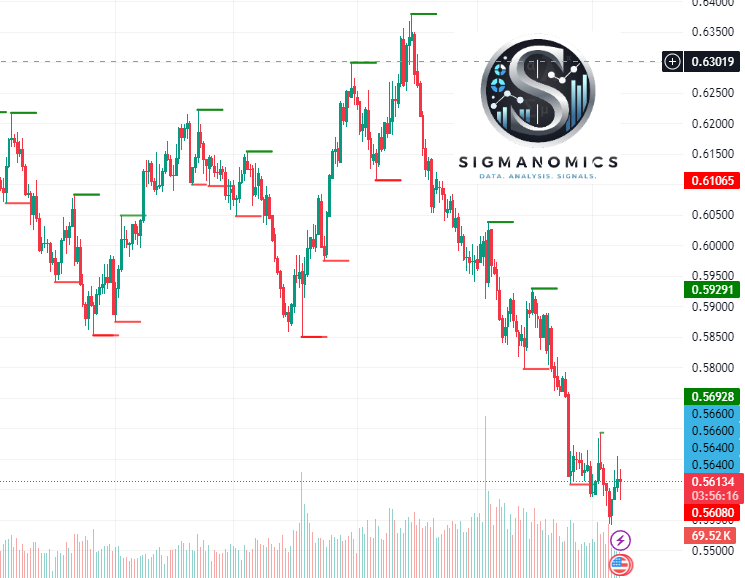The NZD/USD currency pair has been under considerable pressure, reflecting broader economic and market conditions. As seen in the attached chart, the pair has continued its downward trajectory, hovering around the 0.56 mark—a significant decline from its historical highs near 1.49. This trend is indicative of both domestic (economic challenges) in New Zealand and a strong U.S. dollar driven by global uncertainty and tighter monetary policy.
Key Chart Observations
 NZD/USD Daily Chart, Sigmanomics
NZD/USD Daily Chart, Sigmanomics
- Trend Breakdown: The chart illustrates a clear bearish trend, with successive lower highs and lower lows. While there are brief retracements, the broader downward momentum remains intact.
- Support and Resistance:
- The current price of 0.56 aligns with a (key support level), with recent trading activity indicating consolidation at this zone.
- Resistance levels around 0.61 remain unbroken, reflecting the difficulty for bulls to regain control.
- Volume Insights: Increased trading volume near recent lows suggests significant market activity, possibly signaling accumulation by long-term buyers or a continuation of selling pressure.
Economic Data Review
New Zealand’s economic indicators further explain the bearish sentiment surrounding the NZD:
- GDP Contraction:
- (Quarterly GDP) growth declined by 1% in Q3 2024, continuing the trend from the prior -1.1%.
- On an annual basis, GDP contracted by 1.5%, indicating a prolonged economic slowdown.
- Labor Market Weakness:
- Unemployment rose to 4.8%, up from 4.6%, highlighting a loosening labor market.
- This softening could weigh on consumer spending and overall economic activity.
- Inflation Pressures Easing:
- The inflation rate fell to 2.2%, a significant decline from previous levels.
- While lower inflation reduces the need for aggressive monetary tightening, it also reflects weaker demand.
- Interest Rates and Monetary Policy:
- The (Reserve Bank of New Zealand) (RBNZ) maintained the interest rate at 4.25%, suggesting a cautious approach to balancing inflation control and economic growth.
- Higher global interest rates, particularly in the U.S., have made the NZD less attractive to investors, further weakening its performance.
- Trade and External Accounts:
- The balance of trade improved, with a deficit of NZD 437 million in November, compared to a significantly wider deficit of NZD 1544 million previously. However, the current account deficit remains substantial at -6.9% of GDP, highlighting persistent external vulnerabilities.
- Business and Consumer Sentiment:
- Business confidence fell slightly to 62.3, reflecting cautious optimism.
- Consumer confidence improved to 97.5, but remains below the 100 threshold, indicating lingering concerns among households.
Broader Context
- Global Factors:
- The strong U.S. dollar, supported by the Federal Reserve’s hawkish stance, continues to weigh on the NZD.
- Global risk aversion, driven by geopolitical tensions and concerns about global growth, has pushed investors toward safe-haven assets like the USD.
- Domestic Challenges:
- Weak retail sales growth (-0.1% MoM in September) underscores soft consumer demand.
- Slowing building permits and a Manufacturing PMI of 45.5 indicate a contraction in the industrial sector, further pressuring the economy.
Outlook for NZD/USD
The outlook for NZD/USD remains bearish in the short term, driven by both domestic and global headwinds:
- Downside Risks:
- Prolonged economic weakness in New Zealand, reflected by negative GDP growth and a rising unemployment rate.
- Continued divergence in monetary policy, as the RBNZ adopts a cautious stance while the Federal Reserve remains aggressive.
- External risks, such as energy price volatility and geopolitical uncertainties, which could further weaken risk-sensitive currencies like the NZD.
- Upside Potential:
- Any signs of economic stabilization in New Zealand, such as improving GDP growth or a rebound in business activity, could support the NZD.
- A potential shift in the Federal Reserve’s monetary policy stance, if inflation in the U.S. cools faster than expected, could provide relief for the NZD.
Conclusion
The NZD/USD pair is facing significant challenges, driven by domestic economic weakness and global factors favoring the U.S. dollar. While the pair is consolidating near key support levels, the broader bearish trend remains intact. Traders should closely monitor economic data and central bank policy updates for any signs of a potential reversal or further downside acceleration.






